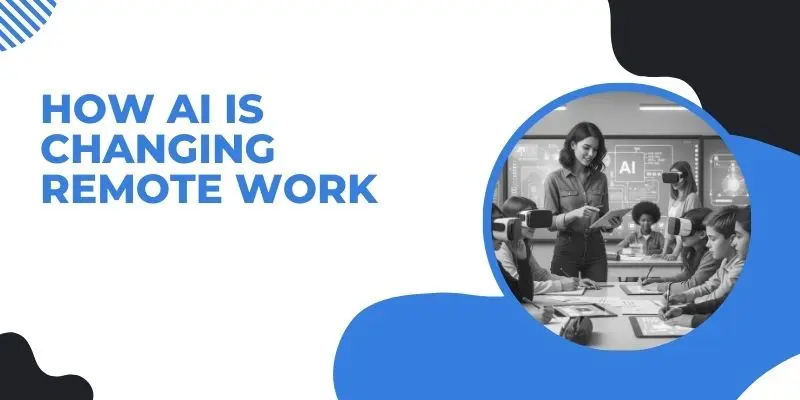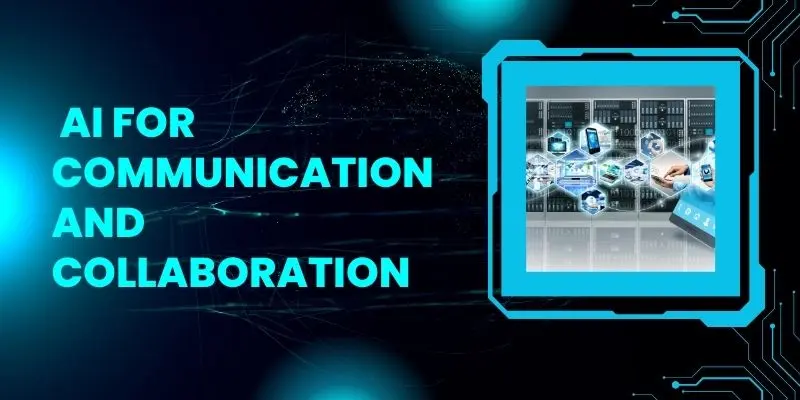AI for Remote Work Productivity – 10 Smart Tools That Will Instantly Boost Your Efficiency
Published: 06 Jul 2025
AI for Remote work productivity is here to stay, and AI is making it smarter, faster, and easier. From managing schedules to automating tasks, AI tools are transforming how teams remain productive from anywhere. They help reduce burnout, improve communication, and eliminate time-wasting routines.
In this article, you’ll discover the most powerful ways AI boosts remote work productivity – and how you can use it to stay ahead.
1. How AI Is Changing Remote Work
The rise of remote work has completely reshaped how businesses operate, and Artificial Intelligence (AI) is right at the center of this transformation. No longer limited to futuristic concepts or massive enterprises, AI is now a practical tool empowering distributed teams, freelancers, and hybrid organizations to work smarter, not harder.

Whether it’s managing daily tasks, improving communication, or automating time-consuming processes, AI is turning remote work into a more productive, flexible, and human-centered experience.
Before I became mainstream, remote workers relied heavily on manual coordination, scheduling meetings, searching for files, replying to emails, and updating spreadsheets. These tasks not only consumed time but also led to burnout. Today, AI-powered productivity tools like virtual assistants, intelligent schedulers, and collaborative platforms are streamlining these operations. For example, AI can automatically generate meeting summaries, prioritize emails based on urgency, or even transcribe and translate conversations in real-time.
But beyond task automation, AI is also reshaping job roles. Instead of replacing human workers, AI complements them, freeing up time for creative, strategic, and interpersonal tasks. This shift is especially valuable in remote settings where communication and trust are critical. As AI continues to evolve, it’s helping remote teams stay aligned, focused, and resilient no matter where they are in the world.
2. Essential AI Tools for Remote Teams
Remote teams thrive when they’re equipped with the right tools, and in 2025, AI-powered productivity apps will be more powerful, accessible, and essential than ever. These tools are no longer just “nice to have”; they’re central to how teams communicate, manage tasks, and stay organized across time zones. Here’s a breakdown of the most effective AI tools, categorized by their core functions, that are boosting performance for remote teams around the world.
AI Chatbots & Virtual Assistants
AI chatbots like ChatGPT, Claude, and Meta AI help remote teams generate quick responses, draft emails, summarize meeting notes, and automate repetitive text-based tasks. These bots integrate with platforms like Gmail, Slack, and Google Docs to streamline communication and content creation without interrupting workflow.
Task & Project Management
Managing deliverables across a distributed team can be challenging, but tools like Asana, Motion, and Any.Do utilize AI to auto-prioritize tasks, suggest optimal schedules, and even adjust deadlines based on productivity patterns. These apps ensure that project tracking remains efficient and goals stay on track, eliminating the need for micromanagement.
Email & Inbox Automation
Remote workers often deal with flooded inboxes. AI tools like Shortwave, Microsoft Copilot Pro, and Gemini for Gmail help by sorting emails, generating smart replies, and syncing schedules across calendars. These tools save hours per week by turning email chaos into a well-organized communication hub.
Search & Knowledge Management
Information retrieval is another big challenge in remote work. Perplexity, Arc Search, and Notion AI offer intelligent search experiences that go beyond keywords, using context and intent to surface the most relevant answers and files, whether from the web or internal databases.
Content & Social Media Creation
For remote marketing or content teams, tools like Jasper, Anyword, and Writer help generate on-brand copy, ads, blog posts, and even video scripts in seconds. Combined with social media managers like Buffer, FeedHive, and Vista Social, remote teams can plan, publish, and track campaigns without missing a beat.
Video & Audio Productivity
Tools like Descript, Runway, and Whisper help remote teams produce high-quality videos, record meetings, transcribe conversations, and edit content collaboratively, all powered by AI. These are especially useful for teams managing training, support content, or YouTube channels remotely.
Scheduling & Calendar Optimization
AI schedulers like Reclaim, Clockwise, and Motion optimize team calendars, balance meeting loads, and suggest ideal times for deep work. They remove the guesswork from time management, a key productivity booster for dispersed teams.
3. AI for Communication and Collaboration
In remote work, clear communication and smooth collaboration are critical but not always easy. Different time zones, asynchronous workflows, and varying work styles can cause delays and misunderstandings.

That’s where AI-powered communication tools come in. They act like invisible team members who help bridge gaps, automate workflows, and ensure that everyone stays informed and connected, no matter where they are in the world.
Real-Time Communication Support with ChatGPT and Claude
ChatGPT and Claude are two leading AI chat assistants that help remote teams communicate more effectively. Whether you’re brainstorming content, writing emails, or summarizing long threads, these tools speed things up dramatically. Instead of spending 20 minutes crafting a client response or clarifying a document, you can prompt ChatGPT or Claude for a draft in seconds, cutting communication delays and improving clarity.
Both tools are particularly helpful for multilingual teams and those working asynchronously, as they help simplify complex messages and provide summaries of conversations for teammates catching up later in the day.
Automation Through Zapier Agents
Zapier Agents act as digital middlemen between the tools your team already uses. For example, a Zapier Agent can take a ChatGPT-generated summary of a Zoom meeting, send it to Slack, and then create a follow-up task in Asana – automatically. This eliminates repetitive tasks like note-sharing, email follow-ups, and task assignments, freeing up team members to focus on what matters most.
By automating cross-tool communication, Zapier makes collaboration across Google Workspace, Slack, Notion, Trello, Zoom, and others feel almost effortless, even if your team is spread across five continents.
Shared Knowledge and Alignment with Notion AI
Notion AI is a powerhouse when it comes to creating and maintaining a shared knowledge base. Remote teams often struggle with keeping information centralized and up-to-date. With Notion AI, team members can turn rough ideas into polished documentation, automatically generate action items from meeting notes, or summarize large documents for new hires, all without starting from scratch.
Because it’s accessible 24/7, Notion AI helps team members jump into any project or conversation with context, even if they missed the live call. This improves onboarding, enhances transparency, and builds a culture of asynchronous alignment.
4. Automating Tasks and Workflow Management
In remote work, staying on top of tasks, meetings, and project timelines can be overwhelming, especially when teams rely on multiple tools scattered across platforms. That’s where AI-powered workflow automation comes into play. The benefits of workflow automation tools like Zapier, Asana, Any.do, and Motion help remote teams cut down on manual work, reduce stress, and focus more on high-value tasks by keeping everything organized and synchronized behind the scenes.
Zapier: The AI Connector for Everything
Zapier is a powerful automation tool that links your favorite apps like Slack, Gmail, Google Sheets, Notion, and more so they work together without manual input. Think of it as your digital assistant that moves information where it needs to go. For example, Zapier can automatically turn form responses into Asana tasks, send updates to Slack, or create Google Calendar events from new Trello cards.
With AI Agents now built into the platform, Zapier can even decide what workflows to trigger based on the context of a message or email, making your automations smarter and more adaptable over time. It’s especially helpful for remote workers who juggle many platforms daily.
Asana: Smart Project Management
Asana remains one of the top choices for managing team projects, especially when enhanced by AI. Its AI-powered features can predict task deadlines, suggest project timelines, and even highlight potential bottlenecks before they happen. For distributed teams, this means less guesswork and fewer status update meetings.
With integrations to tools like Zoom, Slack, and Google Workspace, Asana ensures that everyone on the team – regardless of time zone – knows what’s happening, what’s next, and who’s responsible.
Any.do: Personal Productivity, Powered by AI
While Asana is great for teams, Any.Do shines for personal task management. It uses AI to recommend the best times to complete tasks based on your calendar, habits, and energy levels. You can even create voice reminders and recurring tasks to help you stay on track, perfect for remote workers balancing meetings, deep work, and home responsibilities.
The app’s calendar integration and cross-device syncing make it a favorite for freelancers, solopreneurs, and small remote teams looking to stay productive without overwhelming dashboards.
Motion: The AI Calendar That Plans Your Day for You
Motion takes a unique approach by combining task management with calendar scheduling. It uses AI to automatically plan your day based on priorities, deadlines, and meeting times. If a meeting pops up or something urgent comes in, Motion will reshuffle your schedule—without you lifting a finger.
For remote professionals with packed calendars, this is a game-changer. It ensures you stay productive while maintaining flexibility, without the need to manually block time or reschedule every time something changes.
5. Creating and Enhancing Content with AI
In a remote work setup, content is the glue that holds communication, branding, and collaboration together. Whether it’s internal documentation, social media posts, blog articles, or email copy, content creation and enhancement take up a large part of the workday.

Thanks to AI, tools like Jasper, Grammarly, Wartune, FeedHive, and Buffer are making this process faster, easier, and more effective than ever.
Jasper: AI-Powered Content Creation
Jasper is an all-in-one AI content assistant designed for marketing teams and remote professionals. It can write everything from blog intros and SEO product descriptions to full-length newsletters in a fraction of the time it would take a human. Jasper learns your brand tone, remembers past writing styles, and adapts its outputs to sound human—and uniquely yours.
For distributed teams, this is a game-changer. Instead of spending hours drafting or revising content, Jasper lets everyone from marketers to support reps quickly generate high-quality, on-brand messaging on demand.
Grammarly and Wordtune: Polishing Your Words
Once your content is drafted, it’s time to polish. Grammarly and Wordtune are two AI-powered writing assistants that do just that, making sure your words are clear, concise, and error-free. Grammarly checks for grammar, tone, clarity, and even suggests alternatives if your message could come across as too blunt or too casual.
Wartune, on the other hand, excels at rephrasing sentences to make them sound more professional, more casual, or more persuasive, depending on your need. These tools are especially helpful when English isn’t your first language or when working in fast-paced remote environments where written communication carries extra weight.
FeedHive and Buffer: Smarter Social Media Management
Remote teams often rely on social media to stay connected with clients, customers, or audiences. FeedHive and Buffer simplify this by helping schedule, optimize, and analyze social media posts across platforms like LinkedIn, Instagram, and Twitter (X).
FeedHive uses AI to suggest the best posting times, recycle high-performing content, and even generate new content ideas based on trends. Buffer focuses on scheduling and engagement, allowing team members across different time zones to maintain a consistent brand voice without being online 24/7.
6. AI for Visual and Audio Content Production
Remote teams often need to create engaging visual and audio content, whether for marketing, training, or internal communications. But not everyone has the time or technical skills to produce polished videos, graphics, or voiceovers. That’s where AI-powered creative tools like Runway, Midjourney, ElevenLabs, and Suno are transforming the game, helping remote professionals generate stunning content without needing a studio or a production crew.
Runway: AI Video Creation for Everyone
Runway makes video editing and generation incredibly easy, even for non-editors. With its AI-powered tools, you can remove video backgrounds, generate new video scenes from text prompts, and edit footage with simple commands. One standout feature is “Text to Video,” which lets you describe what you want, and the AI creates it.
For remote teams working on product demos, explainer videos, or social media reels, Runway reduces production time from days to hours, making it possible to create professional-grade content without a big budget or outsourcing.
Midjourney: Turning Words into Stunning Images
When your team needs eye-catching visuals for presentations, blog posts, thumbnails, or social media, Midjourney can help. This text-to-image tool generates detailed and artistic images based on prompts you provide. It’s especially useful for creatives who want unique graphics without using stock photos.
Midjourney allows for incredible customization—style, lighting, realism, even mood. It empowers remote teams to express brand identity visually while saving both time and licensing costs.
ElevenLabs: Natural AI Voiceovers
If you need high-quality, human-like voiceovers, ElevenLabs delivers. This tool generates expressive and realistic audio in multiple languages and tones. Whether you’re creating a narrated tutorial, internal announcement, or customer-facing content, ElevenLabs can produce professional-sounding voiceovers in minutes.
You can even clone voices to keep consistency across projects or match your company’s audio branding. For remote creators and marketers, this eliminates the need to hire voice actors or book studio time.
Suno: Music Generation Made Easy
Need custom background music or jingles? Suno lets you generate original music tracks based on your desired mood, genre, or purpose. Whether you’re creating a podcast intro, a video soundtrack, or just want ambient music for a company event, Suno gives you AI-generated tunes that sound professionally produced.
Its intuitive interface makes it accessible for non-musicians, giving remote teams the ability to add audio flair to content without relying on generic tracks or licensing complications.
7. AI-Powered Scheduling and Inbox Management
In remote work, calendar chaos and email overload are two of the most common productivity killers. Between scattered meeting times, different time zones, and hundreds of unread messages, it’s easy to feel buried. Thankfully, AI-powered tools like Reclaim, Clockwise, Microsoft Copilot, and Gemini for Gmail are changing how remote teams handle scheduling and inbox management, helping them stay organized and stress-free.
Reclaim and Clockwise: Smarter Calendar Syncing
Both Reclaim and Clockwise are built to optimize your calendar without constant micromanaging. Reclaim uses AI to automatically block time for both meetings and deep work based on your priorities, availability, and energy levels. It can also find common free time across teams super helpful when coordinating across multiple time zones.
Clockwise takes a similar approach but adds features like “Focus Time” optimization and smart meeting rescheduling. It helps ensure that collaboration doesn’t come at the expense of personal productivity, especially important for remote workers who juggle both team and solo tasks.
Microsoft Copilot for Outlook: Email, Reimagined
Managing a crowded inbox is another challenge remote workers face daily. Microsoft Copilot for Outlook steps in with AI-driven tools that summarize long email threads, suggest replies, prioritize important messages, and even schedule follow-ups. Instead of manually scanning through dozens of emails, users get a smart, condensed view that lets them act faster and stay on top of communication.
Copilot also works seamlessly with Microsoft 365 tools, making it easy to sync tasks, meetings, and emails across your workflow, all from your inbox.
Gemini for Gmail: Google’s Inbox AI
For those using Gmail, Gemini (formerly Bard) provides AI-powered enhancements similar to Copilot. Gemini helps sort emails, draft replies, and flag urgent messages, all while learning your habits over time. It also integrates with Google Calendar and Google Drive, giving users suggestions based on upcoming events, attachments, and deadlines.
What makes Gemini powerful is its context awareness. For example, if you receive a meeting invite, Gemini can check your availability, suggest a response, and even add the event to your calendar without you lifting a finger.
8. Monitoring Productivity and Measuring Results
As remote teams embrace AI to get work done faster and smarter, one key question remains: How do we know it’s working? Monitoring productivity and measuring outcomes is essential to ensure that AI tools are delivering real value, not just extra noise. Thankfully, a new generation of AI-based reporting and analytics tools makes it easier than ever to track KPIs (Key Performance Indicators), analyze trends, and improve performance across distributed teams.
Tracking KPIs with AI
Key Performance Indicators give teams and leaders a measurable way to evaluate progress. But in remote settings, tracking things like output, efficiency, and collaboration can be tricky. AI tools such as Time Doctor, ActivTrak, or Hubstaff go beyond basic time tracking by analyzing behavioral patterns, app usage, and productivity cycles.
For example, these tools can tell when team members are focused, when they’re frequently switching tasks, or when productivity peaks throughout the day. They also generate custom dashboards that help managers track goals, deadlines, and team health in real time without micromanaging.
Short-Term vs. Long-Term Performance Metrics
AI helps capture both immediate and long-range impacts of remote work. In the short term, teams can monitor response times, project completion rates, client feedback, and employee engagement. For the long term, AI can analyze broader trends such as overall efficiency improvements, project profitability, or retention rates.
Platforms like Microsoft Viva Insights or Notion AI provide automated weekly and monthly summaries that highlight performance shifts, suggest improvements, and flag issues early, giving leadership the data they need to act before productivity drops.
AI-Driven Performance Reviews
Performance evaluations are evolving with AI. Instead of relying solely on quarterly manager feedback, tools now provide continuous performance tracking based on objective data. AI systems can detect improvements in task quality, collaboration frequency, or knowledge-sharing behavior, ensuring team members are recognized fairly, even when working across time zones or on asynchronous schedules.
9. Ethical, Mental Health, and Work-Life Integration
As remote work becomes more AI-powered, it’s important to focus not just on productivity but on people. AI can do more than manage tasks or automate emails; it also plays a role in protecting mental health, promoting work-life balance, and raising serious ethical concerns. For businesses to succeed long-term, they must consider both the human and technological sides of remote work.
AI’s Role in Supporting Mental Well-being
Burnout is a real risk in remote work, especially when there’s no clear boundary between home and office life. AI tools like Reclaim or Clockwise help workers protect their time by automatically scheduling breaks, deep work sessions, and focus blocks. This not only improves output but also encourages employees to take care of their mental health by preventing overscheduling.
AI-powered wellness platforms like Spill or Headspace for Work go a step further by offering virtual mental health support, mood tracking, and even AI-guided journaling or therapy. These tools give employees private, on-demand ways to manage stress and stay emotionally balanced without needing to talk to a manager.
Work-Life Integration: Setting Boundaries with AI
One of the biggest remote work challenges is the blurred line between personal and professional time. AI can help enforce healthier habits by flagging long work hours, suggesting downtime, or even pausing notifications during non-working periods.
For example, AI-enabled calendar assistants can recommend optimal times for meetings based on when you’re most alert and avoid booking after-hours calls. Some tools even let teams agree on “no-meeting zones” or quiet periods to make sure everyone has uninterrupted personal time.
Ethical Considerations in AI Monitoring
As companies use AI to measure productivity and monitor team behavior, ethical concerns arise around privacy, consent, and data usage. It’s essential to maintain transparency: employees should know what’s being tracked, why it matters, and how that data will (or won’t) be used.
Employers must also avoid using AI to push unreasonable expectations or always-on availability. Instead, AI should support a healthy remote culture, not a surveillance one. This includes ensuring fairness in performance reviews, bias-free algorithms, and clear guidelines on responsible AI use.
10. Future Trends and Preparing for the AI Era
As AI becomes more central to how we work, especially in remote and hybrid settings, future-proofing your career and business has never been more important. The companies and professionals who thrive in the AI era will be those who embrace continuous learning, adopt cost-effective tools, and stay agile as the tech continues to evolve.
Upskilling and Career Development in the AI Age
For remote professionals, developing AI literacy is no longer optional. Roles across industries are being reshaped by automation and intelligent systems, but that doesn’t mean jobs are disappearing it means they’re changing. Skills like prompt engineering, AI model evaluation, data storytelling, and using AI productivity tools (like Notion AI or ChatGPT) are becoming essential.
At the same time, soft skills like emotional intelligence, communication, and creative thinking remain critical. AI might summarize notes or write drafts, but it can’t replace human judgment, charisma, or strategic leadership. That’s why professionals should invest time in learning how to work alongside AI, not compete against it.
Online platforms like Coursera, LinkedIn Learning, and HBS Online offer specialized AI courses tailored for business leaders, marketers, and remote teams. Making these part of your team’s development plan now will pay off in long-term adaptability and resilience.
Affordable AI Adoption for Small and Medium Businesses (SMEs)
You don’t need to be a tech giant to benefit from AI. Cost-effective AI tools are more accessible than ever for SMEs. Platforms like Zapier, Otter.ai, Grammarly, and Motion offer AI-driven features that save time, automate repetitive tasks, and boost productivity without requiring large upfront investments.
Small businesses can start by identifying 2–3 manual workflows like client onboarding, invoice tracking, or social media management, and automating them with AI assistants or bots. Many tools offer freemium or low-cost tiers that make experimentation easy.
The key is to integrate AI gradually and strategically align tools with business goals while keeping ethical and human-centered values in place. As AI continues to evolve, staying competitive will be about learning, adapting, and leading with trust.
Conclusion
AI is no longer just a buzzword; it’s a real game-changer for remote teams. From smarter scheduling to powerful content creation, ethical monitoring, and career development, AI for Remote Work Productivity empowers teams to work better, not just harder. Whether you’re part of a growing startup or leading a global distributed team, embracing AI means unlocking new levels of efficiency, collaboration, and well-being. Now is the time to explore, experiment, and evolve, because the future of remote work is already here—and it’s powered by AI.
FAQs
Yes, AI is making remote work easier by automating tasks, managing schedules, and improving communication. It allows teams to stay productive from anywhere in the world.
Absolutely. AI speeds up repetitive tasks, reduces errors, and helps workers focus on creative and strategic work, boosting overall efficiency.
Start by using AI tools like ChatGPT for writing, Motion for scheduling, and Grammarly for editing. These tools help save time and keep your workflow smooth.
AI supports remote work by handling admin tasks, syncing calendars, transcribing meetings, and even managing emails. It’s like having a smart assistant on your team.
Remote work will rely more on AI for communication, task automation, and mental wellness support. Teams will use AI to work smarter, not harder.
No, AI is designed to assist, not replace humans. It takes care of repetitive tasks so people can focus on decision-making, creativity, and relationships.
Top tools include Notion AI for notes, Reclaim for smart scheduling, and Zapier for workflow automation. Each tool solves a different productivity problem.
Yes, AI tools can analyze your habits and schedule tasks at the best times. Apps like Clockwise and Motion are great examples of this.
AI can schedule breaks, block focus time, and reduce after-hours work alerts. This helps remote workers stay mentally healthy and avoid burnout.
Yes, issues like privacy, data use, and employee monitoring must be handled with transparency. Ethical AI use means respecting boundaries while boosting productivity.

- Be Respectful
- Stay Relevant
- Stay Positive
- True Feedback
- Encourage Discussion
- Avoid Spamming
- No Fake News
- Don't Copy-Paste
- No Personal Attacks

- Be Respectful
- Stay Relevant
- Stay Positive
- True Feedback
- Encourage Discussion
- Avoid Spamming
- No Fake News
- Don't Copy-Paste
- No Personal Attacks





